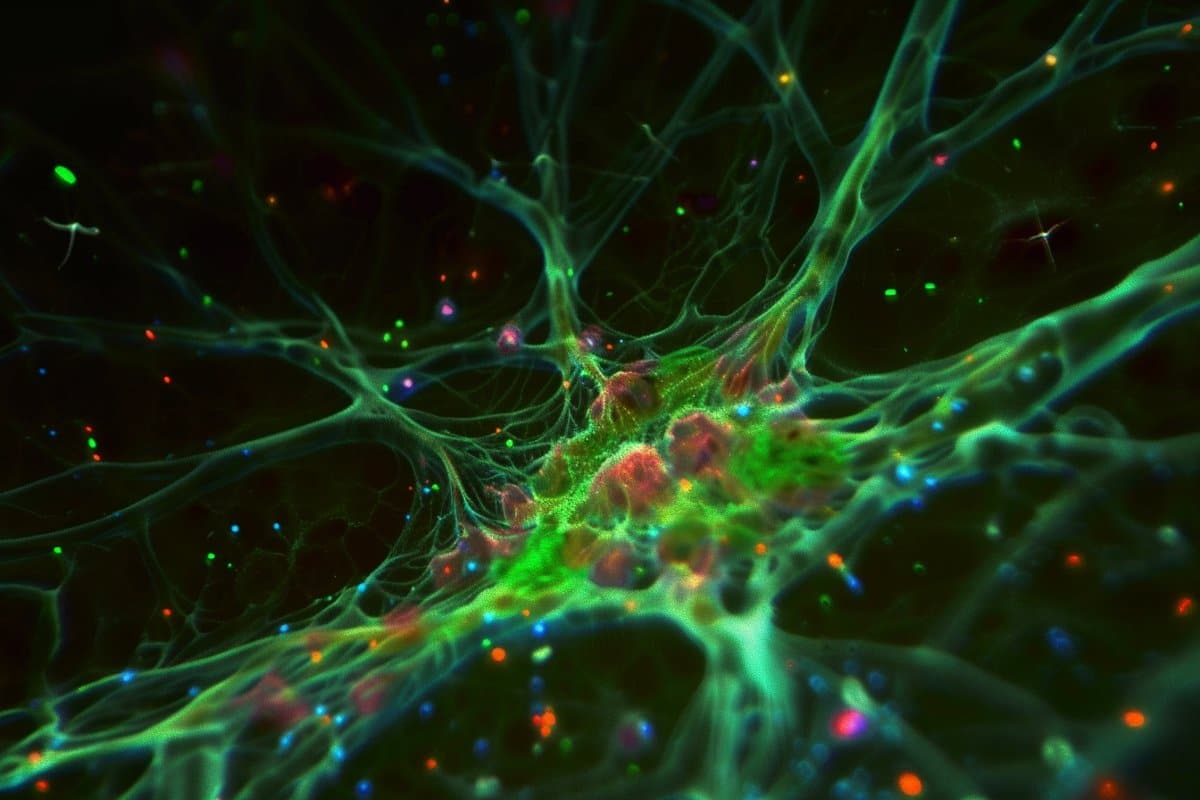Summary: Researchers have identified a critical protein, FAM81A, that plays a pivotal role in forming postsynaptic protein agglomerations, essential for synaptic function in the brain. By analyzing 35 previous studies, the team discovered FAM81A’s consistent presence in the postsynaptic density, a complex protein structure vital for neuron signal transmission.
This protein’s interaction with major postsynaptic proteins and its involvement in liquid-liquid phase separation underscore its significance in maintaining synaptic activity. The findings not only contribute to our understanding of synaptic mechanisms but also open new avenues for exploring the evolution of cognitive functions in higher vertebrates and potential implications for neuropsychiatric conditions.
Key Facts:
- FAM81A’s Crucial Role in Synapses: FAM81A interacts with key postsynaptic proteins, regulating their assembly and impacting neuron function.
- First Comprehensive Characterization: This study provides the first full characterization of FAM81A, highlighting its involvement in the synaptic density’s formation and activity.
- Evolutionary Insights: The evolutionary divergence between FAM81A and its homologs across species suggests its unique role in the cognitive functions of higher vertebrates’ brains.
Source: Kobe University
A protein that appears in postsynaptic protein agglomerations has been found to be crucial to their formation. The Kobe University discovery identifies a new key player for synaptic function and sheds first light on its hitherto uncharacterized cellular role and evolution.
What happens at the synapse, the connection between two neurons, is a key factor in brain function. The transmission of the signal from the presynaptic to the postsynaptic neuron is mediated by proteins and their imbalance can lead to neuropsychiatric conditions such as severe depression, autism, or alcohol dependence.
However, due to the vast diversity of proteins present at this junction, many have not yet been studied and often it is not even clear whether those previously found actually belong there or whether they are just impurities resulting from the analysis process.
A particularly conspicuous structure directly underneath the postsynaptic membrane is the so-called “postsynaptic density,” an agglomeration of possibly thousands of different proteins.
To shed some light on the postsynaptic density, Kobe University neurophysiologist TAKUMI Toru and his group first compared 35 datasets of previous studies on the phenomenon to find out which uncharacterized proteins appear consistently.
KAIZUKA Takeshi, the first author of the paper, explains, “We established an analytical pipeline to unify and align protein structures in different datasets. This resulted in the identification of a poorly characterized synaptic protein that has been detected in more than 20 of these datasets.”
This suggested that the protein, which goes by the label FAM81A, is probably relevant to the function of the whole structure, so the team analyzed its interactions with other proteins, its distribution in and around neurons and its effect on neuron shape and function, the mechanism of its function, and its evolution. In short, they gave this protein a full first characterization.
Takumi summarizes their results, now published in the journal PLoS Biology, “The important finding is that FAM81A interacts with at least three major postsynaptic proteins and modulates their condensation. This suggests that FAM81A is a major regulatory factor in the postsynaptic density.”
The group could confirm that FAM81A facilitates the condensation of key proteins into a membrane-less organelle through liquid-liquid phase separation, a process in which strongly interacting molecules exclude elements of the surrounding medium, and that the absence of the protein leads to a significant decrease of activity in cultured neurons.
Humans have two related copies of the gene, FAM81A and FAM81B. However, while FAM81A is expressed in the brain, FAM81B is expressed only in the testes. Furthermore, birds and reptiles also have two copies of the gene, but amphibians, fish and invertebrates have only one, and its expression is not localized to one tissue.
“Interestingly, it seems that the evolutionary conservation of FAM81A function in the synapse is limited compared to other synaptic molecules, as the FAM81A homolog in fish is not detected in the synapse. This suggests that FAM81A could be a key protein in understanding the cognitive functions of higher vertebrate brains,” says Kaizuka.
But their work was only the first step. To really understand the role of the protein, it is necessary to study its function in the complex environment of the brain. The Kobe University research team thus wants to create mouse models that lack the gene for FAM81A and study what this means both for the function of the synapses and the behavior of the organism.
Funding: This research was supported by the Japan Society for the Promotion of Science (grant JP16H06463, JP18K14830, JP22H04981, JP23H04233), the Japan Science and Technology Agency (JPMJMS2299), and the Takeda Science Foundation.
It was conducted in collaboration with researchers from the University of Edinburgh, Kyoto University and the University of Sheffield.
About this genetics and neuroscience research news
Author: Daniel Schenz
Source: Kobe University
Contact: Daniel Schenz – Kobe University
Image: The image is credited to Neuroscience News
Original Research: Open access.
“FAM81A is a postsynaptic protein that regulates the condensation of postsynaptic proteins via liquid-liquid phase separation” by TAKUMI Toru et al. PLOS Biology
Abstract
FAM81A is a postsynaptic protein that regulates the condensation of postsynaptic proteins via liquid-liquid phase separation
Proteome analyses of the postsynaptic density (PSD), a proteinaceous specialization beneath the postsynaptic membrane of excitatory synapses, have identified several thousands of proteins.
While proteins with predictable functions have been well studied, functionally uncharacterized proteins are mostly overlooked. In this study, we conducted a comprehensive meta-analysis of 35 PSD proteome datasets, encompassing a total of 5,869 proteins.
Employing a ranking methodology, we identified 97 proteins that remain inadequately characterized. From this selection, we focused our detailed analysis on the highest-ranked protein, FAM81A.
FAM81A interacts with PSD proteins, including PSD-95, SynGAP, and NMDA receptors, and promotes liquid–liquid phase separation of those proteins in cultured cells or in vitro. Down-regulation of FAM81A in cultured neurons causes a decrease in the size of PSD-95 puncta and the frequency of neuronal firing.
Our findings suggest that FAM81A plays a crucial role in facilitating the interaction and assembly of proteins within the PSD, and its presence is important for maintaining normal synaptic function.
Additionally, our methodology underscores the necessity for further characterization of numerous synaptic proteins that still lack comprehensive understanding.

Dr. Sarah Adams is a scientist and science communicator who makes complex topics accessible to all. Her articles explore breakthroughs in various scientific disciplines, from space exploration to cutting-edge research.







